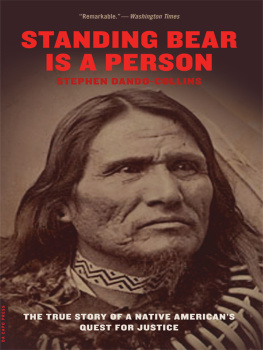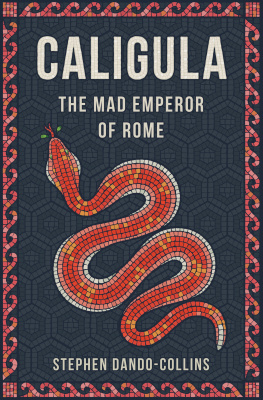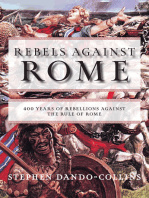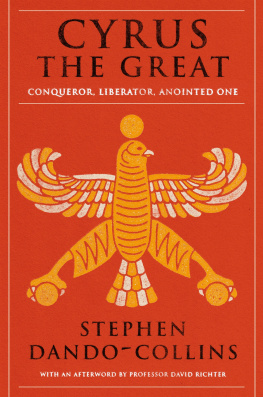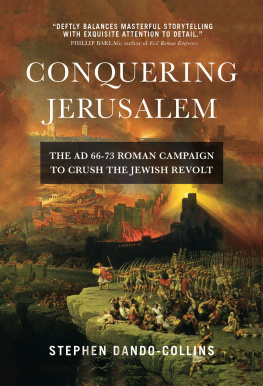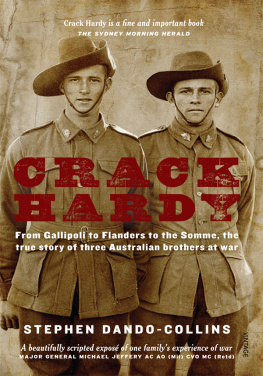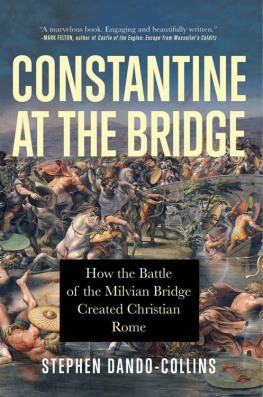Stephen Dando-Collins - Standing Bear Is a Person
Here you can read online Stephen Dando-Collins - Standing Bear Is a Person full text of the book (entire story) in english for free. Download pdf and epub, get meaning, cover and reviews about this ebook. year: 2011, publisher: Da Capo Press, genre: Detective and thriller. Description of the work, (preface) as well as reviews are available. Best literature library LitArk.com created for fans of good reading and offers a wide selection of genres:
Romance novel
Science fiction
Adventure
Detective
Science
History
Home and family
Prose
Art
Politics
Computer
Non-fiction
Religion
Business
Children
Humor
Choose a favorite category and find really read worthwhile books. Enjoy immersion in the world of imagination, feel the emotions of the characters or learn something new for yourself, make an fascinating discovery.
- Book:Standing Bear Is a Person
- Author:
- Publisher:Da Capo Press
- Genre:
- Year:2011
- Rating:3 / 5
- Favourites:Add to favourites
- Your mark:
- 60
- 1
- 2
- 3
- 4
- 5
Standing Bear Is a Person: summary, description and annotation
We offer to read an annotation, description, summary or preface (depends on what the author of the book "Standing Bear Is a Person" wrote himself). If you haven't found the necessary information about the book — write in the comments, we will try to find it.
The only book about the landmark trial of the first Native American to be recognized legally as a person-an eloquent reminder of a fight well fought. Kirkus
Standing Bear Is a Person — read online for free the complete book (whole text) full work
Below is the text of the book, divided by pages. System saving the place of the last page read, allows you to conveniently read the book "Standing Bear Is a Person" online for free, without having to search again every time where you left off. Put a bookmark, and you can go to the page where you finished reading at any time.
Font size:
Interval:
Bookmark:
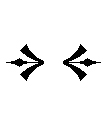

Copyright 2004 by Stephen Dando-Collins
All rights reserved. No part of this publication may be reproduced, stored in a retrieval system, or transmitted, in any form or by any means, electronic, mechanical, photocopying, recording, or otherwise, without the prior written permission of the publisher. Printed in the United States of America.
Designed by Brent Wilcox
Set in 10.75-point Fairfield Light by the Perseus Books Group
Library of Congress has catalogued the hardcover edition as follows:
Dando-Collins, Stephen.
Standing Bear is a person : the true story of a Native American's quest for justice / Stephen Dando-Collins.
p. cm.
Includes bibliographical references and index.
ISBN 0-306-81370-X (hardcover : alk. paper)
eBook ISBN: 9780786738120
1. Standing Bear, Ponca chief. 2. Ponca IndiansKings and rulersBiography. 3. Ponca IndiansRelocation. 4. Ponca IndiansClaims. 5. Ponca IndiansLegal status, laws, etc.
I. Title.
E99.P7S833 2004
978.004'9752539'0092dc22
2004014783
First Da Capo Press paperback edition, 2005
ISBN-10: 0-306-81441-2
ISBN-13: 978-0-306-81441-9
Published by Da Capo Press
A Member of the Perseus Books Group
http://www.dacapopress.com
Da Capo Press books are available at special discounts for bulk purchases in the U.S. by corporations, institutions, and other organizations. For more information, please contact the Special Markets Department at the Perseus Books Group, 11 Cambridge Center, Cambridge, MA 02142, or call (800) 255-1514 or (617) 252-5298, or email .
This book began in the 1970s with a curiosity to learn more about Standing Bear and the Poncas after I read a brief chapter about their struggles in Dee Browns Bury My Heart at Wounded Knee. In the 1990s my research gathered pace. The more I learned, the more the story haunted me. In recent times the project has garnered a host of supporters. My special thanks go to the Ponca tribe of Nebraska, in particular Chairman Mark Peniska and special projects coordinator Shaune Bell for her patient collaboration. Also to the Omaha tribe of Nebraska and Iowa, in particular Chairman Donald Grant, and to the dedicated Richard Chilton of the Omaha Tribal Historical Research Project. My sincere thanks also go to the Ponca for welcoming my wife and me to their annual powwow. Im also greatly indebted to John Gottschalk, publisher of the Omaha World-Herald newspaper, the modern-day successor to T. H. Tibbless paper, and his hard-working assistant Donna Grimm, for their detailed assistance.
To Marnie Cochran and Bob Pigeon at Perseus Books, thank you for seeing the potential of Standing Bears story and for steering me down the focused path. My grateful thanks too go to my New York literary agent, Richard Curtis, who has guided and encouraged me and championed my workour collaboration has been one of the joys of my life. But the greatest joy of my life is my wife, Louise, who has shared all the joys and disappointments of the writers life with me for many years, and who, like me, abhors injustice. One of Louises friends calls her Mrs. Sparkle; she does indeed put a sparkle in my every day.
Should you ever venture to northern Oklahoma and visit a little metropolis near the Kansas state line called Ponca City, population 25,000, you will see an Indian chief who stands twenty-two feet tall and weighs four thousand pounds. You will be looking at a bronze statue of Standing Bear, or Machunazha as he was known in his own tongue, clan chief of the Poncas, the small Native American tribe for which the city is named. The statue, proudly dedicated by the city fathers in 1996, is the work of sculptor Oreland C. Joe. Ironically, this is the last place Standing Bear ever wanted to be.
In 1879, so determined was Standing Bear not to live here beside the Arkansas River in Oklahoma, he took the U.S. government to court, creating a legal case without precedent in U.S. history. Standing Bear and his people wished to live and die on the land of their birth, a thousand miles away in northeastern Nebraska, rather than in the Warm Land, as the Poncas called Oklahoma, the alien place to which the U.S. Army had marched Standing Bear and the Ponca tribe at the point of a bayonet two years earlier.
Before the Standing Bear case went to court, few Americans had ever heard of the small Ponca tribe. Suddenly the story grabbed the headlines across the country, and the name Standing Bear was on millions of lips. As editorial writers from New England to California told their readers, the outcome of the case could not only change the fate of the peaceable Poncas but terminate the forced removal of all Native Americans from their traditional lands and end the Indian reservation system, the system at the heart of government policy for westward expansion of the United States.
This is the story of that case, and its repercussions. An adventure story. A love story. A unique human rights story. It is also the story of an unusual coalition of players who paved Standing Bears path to U.S. district court in April 1879an army general who was considered Americas greatest Indian fighter, a crusading newspaper editor who was once a gun-toting frontier preacher, a young attorney who had a brilliant idea but doubted the case could be won and another lawyer who hadnt appeared in court in sixteen years, and a shy Indian princess who became world famous. The tale you are about to read has all the hallmarks of a Hollywood epic, but it is very much a true story.
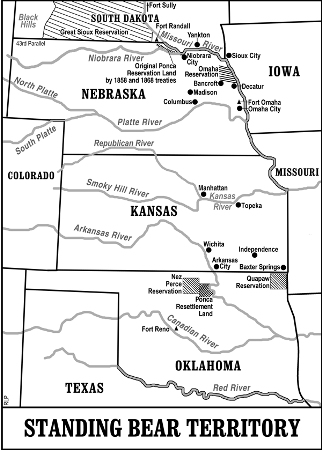
If we can do something for which good men will
remember us when we are gone, that is the best
legacy we can leave.
General George Crook,
U.S. Army (1879)
THE PRINCESS AND THE GENERAL
I T WAS LATE in the afternoon of March 29, a Saturday in the early spring of 1879. Thirty-two-year-old Lieutenant John Gregory Bourke, West Point graduate, Medal of Honor winner, and aide-de-camp to Brigadier General George Crook, commander of the Military Department of the Platte, slowly made his way across the parade ground at Fort Omaha, Nebraska, toward the generals headquarters.
Bourke, a man of medium height and solid build who sported a bushy mustache beneath a prominent nose, glanced over his shoulder with deep-set gray eyes to two Indians in European dress who followed on his heel. Bourke allowed the pace to be dictated by the solid man of medium height who came immediately behind himIron Eye, paramount chief of the Omaha tribe. The fifty-seven-year-old chief walked with a labored limp. Years before, Iron Eye lost a leg to a surgeons knife after stepping on a rusty nail, and the doctors provided a wooden and later a cork substitute. Although the false leg slowed him down when he was on his feet, he was a horseman without peer. Behind the chief came his eldest daughter, Bright Eyes, a diminutive twenty-four-year-old who wore a dark ankle-length dress and had her hair neatly tied back. Bourke knew that the Omahas werent comfortable in the heart of the U.S. Army post, having come down off their reservation near Decatur in northeastern Nebraska without government permission, but he also knew that they had come on a mission. Without a word and with blinkered determination, the pair traipsed along behind the lieutenant, across the forts parade.
Font size:
Interval:
Bookmark:
Similar books «Standing Bear Is a Person»
Look at similar books to Standing Bear Is a Person. We have selected literature similar in name and meaning in the hope of providing readers with more options to find new, interesting, not yet read works.
Discussion, reviews of the book Standing Bear Is a Person and just readers' own opinions. Leave your comments, write what you think about the work, its meaning or the main characters. Specify what exactly you liked and what you didn't like, and why you think so.

